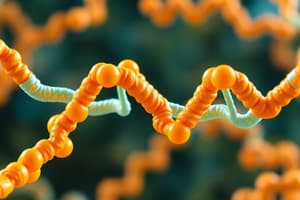Podcast
Questions and Answers
What is the three-letter code for Glutamine?
What is the three-letter code for Glutamine?
Gln
Which amino acid has the three-letter code 'Ile'?
Which amino acid has the three-letter code 'Ile'?
Isoleucine
Identify an amino acid with the three-letter code 'Cys'.
Identify an amino acid with the three-letter code 'Cys'.
Cysteine
Which amino acid corresponds to the three-letter code 'Asp'?
Which amino acid corresponds to the three-letter code 'Asp'?
List the three-letter code for Phenylalanine.
List the three-letter code for Phenylalanine.
Discuss the importance of amino acids in protein synthesis, and name any two amino acids that are essential in the human diet.
Discuss the importance of amino acids in protein synthesis, and name any two amino acids that are essential in the human diet.
Explain the role of cysteine in biological systems and identify another amino acid that contains sulfur in its structure.
Explain the role of cysteine in biological systems and identify another amino acid that contains sulfur in its structure.
How do the side chains of amino acids influence protein function? Provide an example with its corresponding three-letter code.
How do the side chains of amino acids influence protein function? Provide an example with its corresponding three-letter code.
Describe the significance of isoelectric point in relation to amino acids, particularly using Glutamic acid as an example.
Describe the significance of isoelectric point in relation to amino acids, particularly using Glutamic acid as an example.
Analyze how the structure of tryptophan contributes to its role as a precursor for neurotransmitters, including its three-letter code.
Analyze how the structure of tryptophan contributes to its role as a precursor for neurotransmitters, including its three-letter code.
Study Notes
Naturally Occurring Amino Acids
- There are 20 standard amino acids that serve as building blocks for proteins.
- Each amino acid is represented by a unique three-letter code, facilitating shorthand notation in biological contexts.
List of Amino Acids and Their Codes
- Alanine (Ala): Non-polar, aliphatic amino acid.
- Arginine (Arg): Polar, positively charged; involved in urea cycle and protein synthesis.
- Asparagine (Asn): Polar, neutral; plays a role in protein structure and function.
- Aspartic acid (Asp): Polar, negatively charged; important for neurotransmitter functions.
- Cysteine (Cys): Contains thiol group; important for forming disulfide bonds in proteins.
- Glutamic acid (Glu): Polar, negatively charged; acts as a neurotransmitter.
- Glutamine (Gln): Polar, neutral; vital for nitrogen transport in the body.
- Glycine (Gly): Smallest amino acid; flexible and helps in protein structure.
- Histidine (His): Polar, positively charged; plays a key role in enzyme catalysis.
- Isoleucine (Ile): Essential branched-chain amino acid; important for muscle metabolism.
- Leucine (Leu): Essential, branched-chain amino acid; critical for protein synthesis regulation.
- Lysine (Lys): Essential, positively charged; important for growth and repair.
- Methionine (Met): Essential sulfur-containing amino acid; initiates protein synthesis.
- Phenylalanine (Phe): Essential, aromatic amino acid; precursor for neurotransmitters.
- Proline (Pro): Unique cyclic structure; aids in protein folding and stability.
- Serine (Ser): Polar, neutral; involved in metabolic pathways and protein phosphorylation.
- Threonine (Thr): Essential polar amino acid; important for protein synthesis.
- Tryptophan (Trp): Essential aromatic amino acid; precursor to serotonin.
- Tyrosine (Tyr): Non-essential, aromatic amino acid; involved in hormone production.
- Valine (Val): Essential branched-chain amino acid; supports muscle metabolism and tissue repair.
Naturally Occurring Amino Acids
- There are 20 standard amino acids that serve as building blocks for proteins.
- Each amino acid is represented by a unique three-letter code, facilitating shorthand notation in biological contexts.
List of Amino Acids and Their Codes
- Alanine (Ala): Non-polar, aliphatic amino acid.
- Arginine (Arg): Polar, positively charged; involved in urea cycle and protein synthesis.
- Asparagine (Asn): Polar, neutral; plays a role in protein structure and function.
- Aspartic acid (Asp): Polar, negatively charged; important for neurotransmitter functions.
- Cysteine (Cys): Contains thiol group; important for forming disulfide bonds in proteins.
- Glutamic acid (Glu): Polar, negatively charged; acts as a neurotransmitter.
- Glutamine (Gln): Polar, neutral; vital for nitrogen transport in the body.
- Glycine (Gly): Smallest amino acid; flexible and helps in protein structure.
- Histidine (His): Polar, positively charged; plays a key role in enzyme catalysis.
- Isoleucine (Ile): Essential branched-chain amino acid; important for muscle metabolism.
- Leucine (Leu): Essential, branched-chain amino acid; critical for protein synthesis regulation.
- Lysine (Lys): Essential, positively charged; important for growth and repair.
- Methionine (Met): Essential sulfur-containing amino acid; initiates protein synthesis.
- Phenylalanine (Phe): Essential, aromatic amino acid; precursor for neurotransmitters.
- Proline (Pro): Unique cyclic structure; aids in protein folding and stability.
- Serine (Ser): Polar, neutral; involved in metabolic pathways and protein phosphorylation.
- Threonine (Thr): Essential polar amino acid; important for protein synthesis.
- Tryptophan (Trp): Essential aromatic amino acid; precursor to serotonin.
- Tyrosine (Tyr): Non-essential, aromatic amino acid; involved in hormone production.
- Valine (Val): Essential branched-chain amino acid; supports muscle metabolism and tissue repair.
Studying That Suits You
Use AI to generate personalized quizzes and flashcards to suit your learning preferences.
Description
Test your knowledge on the 20 standard amino acids and their unique three-letter codes. This quiz covers the properties, functions, and significance of each amino acid in biological contexts. Perfect for students studying biochemistry or molecular biology.




